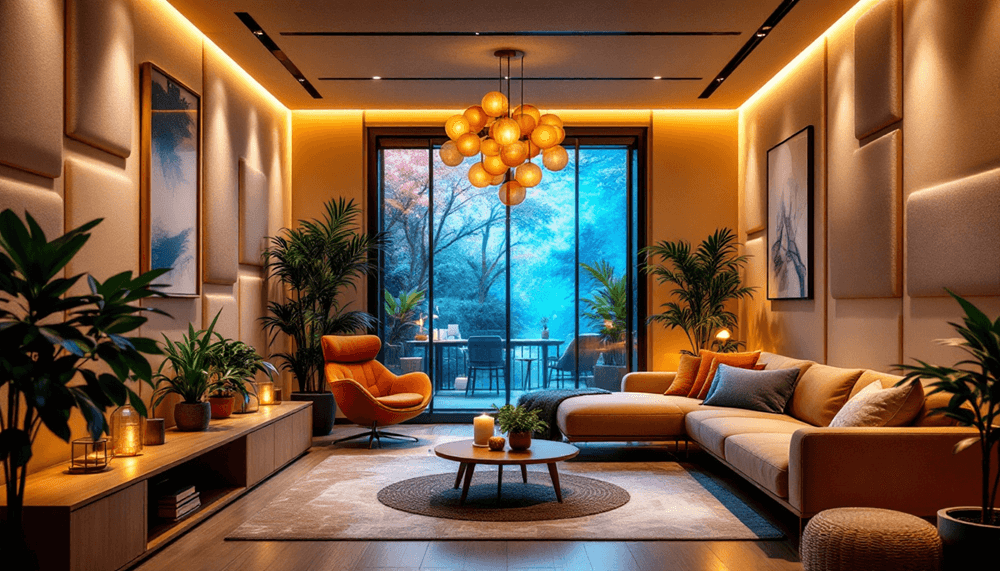Lighting in Interior Design
Lighting is not only a visual element in interior design but also an element that has a significant impact on an individual’s physiological and psychological health. Lighting is like a magical wand that reveals this potential and gives life to spaces. It not only ensures a room’s visibility but also defines its atmosphere, influences emotions, and even shapes physiological processes.
Methods Used in Lighting Design
- Natural
Light: By incorporating as much natural light as possible, the aim is to make interior spaces more open and healthy. Large windows, skylights, and light wells allow natural light to enter.
- Artificial
Light: Artificial light is used in situations where natural light is insufficient or when different atmospheres are desired.
- Lighting
Layers: Different lighting layers are used in a space, including general lighting, task lighting, and accent lighting.
- Biodynamic - Biorhythmic Lighting: This lighting system changes according to the body’s biological clock. By using lights with different color temperatures and intensities at various times of the day, the natural light cycle is mimicked.
- Human-Centered Lighting: Human-centered lighting is designed by considering an individual’s biological, psychological, and social needs.
- Sustainable
Lighting: Thanks to LED technologies, energy-efficient and long-lasting lighting solutions are being developed.
- Smart
Lighting Systems: Thanks to IoT technologies, lighting systems have become smarter. These systems, controllable by voice or apps, offer personalized lighting experiences.
Lighting and Healthy Living Spaces
- Offices: Task lighting and natural light enhance employees’ productivity.
- Homes: Dim lighting in bedrooms promotes sleep, while adequate lighting in work areas enhances focus.
- Schools: Natural light and an efficient lighting system positively influence students’ learning processes.
- Healthcare Facilities: Soothing colors and dim lighting help patients relax.
Direct or Indirect Effects of Lighting on Human Health
Lighting is one of the most important factors determining the aesthetics of a space. With various light sources, color temperatures, and directions, we can add depth, dynamism, and drama to spaces. However, the effects of lighting are not limited to that. Scientific studies have revealed the profound effects of light on human health and psychology.
- Regulating the Circadian Rhythm: Natural light affects the secretion of melatonin, the hormone that regulates the body’s internal clock. Therefore, exposure to sufficient natural light is important for regulating sleep patterns and improving mood.
- Biological Clock and Melatonin: Natural light affects the secretion of melatonin, the hormone that regulates our biological clock. Exposure to sufficient natural light is important for regulating sleep patterns and enhancing mood.
- Focus and Productivity: The right lighting level increases visual comfort, enhancing focus and productivity. In work areas, task lighting, which directs light onto the work surface, is highly effective.
- Mood: The color and intensity of light affect a person’s emotional state.
- Perception of Space: Lighting influences how we perceive the dimensions, proportions, and even the warmth of a space. For example, overhead lighting can make a space appear taller, while light reflected on walls can make it seem more spacious.
- Vitamin D Production: Sunlight is essential for the body to produce vitamin D, which is important for bone health, the immune system, and mood.
Considerations in Lighting Design
- Function of the Space: Every space has different lighting needs. For example, while a warm and inviting atmosphere is desired in a living room, a more functional lighting is required in a kitchen.
- Color Temperature: The color of light determines the atmosphere of a space. Warm colors are relaxing, while cool colors create a more energetic ambiance.
- Direction: The direction of light affects the depth and dimensions of a space.
- Shading: Shading prevents glare and increases visual comfort.
- Energy Efficiency: Energy-efficient lighting solutions, such as LED technologies, should be preferred.
- Color Temperature: The color of light is measured in Kelvin (K). Warm white light (2700-3300K) is more yellowish and soothing, while cool white light (5000K and above) is more bluish and enhances focus.







